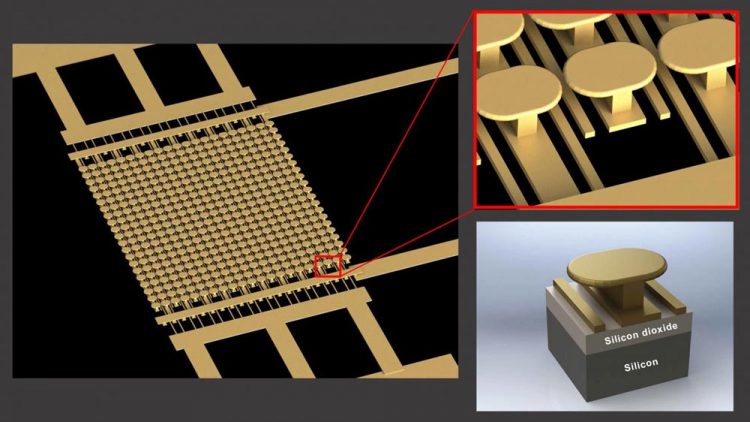Semiconductor-free microelectronics are now possible, thanks to metamaterials

This is the designed semiconductor-free microelectronic device. Credit: UC San Diego Applied Electromagnetics Group
The discovery paves the way for microelectronic devices that are faster and capable of handling more power, and could also lead to more efficient solar panels. The work was published Nov. 4 in Nature Communications.
The capabilities of existing microelectronic devices, such as transistors, are ultimately limited by the properties of their constituent materials, such as their semiconductors, researchers said.
For example, semiconductors can impose limits on a device's conductivity, or electron flow. Semiconductors have what's called a band gap, meaning they require a boost of external energy to get electrons to flow through them. And electron velocity is limited, since electrons are constantly colliding with atoms as they flow through the semiconductor.
A team of researchers in the Applied Electromagnetics Group led by electrical engineering professor Dan Sievenpiper at UC San Diego sought to remove these roadblocks to conductivity by replacing semiconductors with free electrons in space. “And we wanted to do this at the microscale,” said Ebrahim Forati, a former postdoctoral researcher in Sievenpiper's lab and first author of the study.
However, liberating electrons from materials is challenging. It either requires applying high voltages (at least 100 Volts), high power lasers or extremely high temperatures (more than 1,000 degrees Fahrenheit), which aren't practical in micro- and nanoscale electronic devices.
To address this challenge, Sievenpiper's team fabricated a microscale device that can release electrons from a material without such extreme requirements. The device consists of an engineered surface, called a metasurface, on top of a silicon wafer, with a layer of silicon dioxide in between. The metasurface consists of an array of gold mushroom-like nanostructures on an array of parallel gold strips.
The gold metasurface is designed such that when a low DC voltage (under 10 Volts) and a low power infrared laser are both applied, the metasurface generates “hot spots”–spots with a high intensity electric field–that provide enough energy to pull electrons out from the metal and liberate them into space.
Tests on the device showed a 1,000 percent change in conductivity. “That means more available electrons for manipulation,” Ebrahim said.
“This certainly won't replace all semiconductor devices, but it may be the best approach for certain specialty applications, such as very high frequencies or high power devices,” Sievenpiper said.
According to researchers, this particular metasurface was designed as a proof-of-concept. Different metasurfaces will need to be designed and optimized for different types of microelectronic devices.
“Next we need to understand how far these devices can be scaled and the limits of their performance,” Sievenpiper said. The team is also exploring other applications for this technology besides electronics, such as photochemistry, photocatalysis, enabling new kinds of photovoltaic devices or environmental applications.
###
Full paper: “Photoemission-based microelectronic devices.” Authors of the study are Ebrahim Forati, Tyler J. Dill, Andrea R. Tao and Dan Sievenpiper.
This work was funded by Defense Advanced Research Projects Agency (grant N00014-13-1-0618) and the Office of Naval Research Defense University Research Instrumentation Program (grant N00014-13-1-0655).
Media Contact
All latest news from the category: Power and Electrical Engineering
This topic covers issues related to energy generation, conversion, transportation and consumption and how the industry is addressing the challenge of energy efficiency in general.
innovations-report provides in-depth and informative reports and articles on subjects ranging from wind energy, fuel cell technology, solar energy, geothermal energy, petroleum, gas, nuclear engineering, alternative energy and energy efficiency to fusion, hydrogen and superconductor technologies.
Newest articles

NASA: Mystery of life’s handedness deepens
The mystery of why life uses molecules with specific orientations has deepened with a NASA-funded discovery that RNA — a key molecule thought to have potentially held the instructions for…

What are the effects of historic lithium mining on water quality?
Study reveals low levels of common contaminants but high levels of other elements in waters associated with an abandoned lithium mine. Lithium ore and mining waste from a historic lithium…

Quantum-inspired design boosts efficiency of heat-to-electricity conversion
Rice engineers take unconventional route to improving thermophotovoltaic systems. Researchers at Rice University have found a new way to improve a key element of thermophotovoltaic (TPV) systems, which convert heat…



